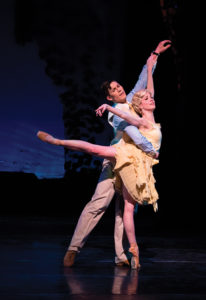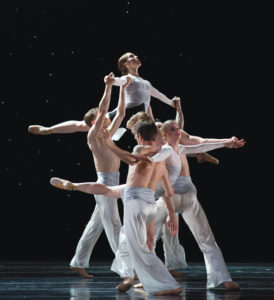Re-inventing BalletMet: Edwaard Liang finds his way forward - Vancouver Ballet Society
- Home
- Features 2015 - 2019
- Re-inventing BalletMet: Edwaard Liang finds his way forward

by Steve Sucato

On an unseasonably warm afternoon last December at BalletMet’s studios in Columbus, Ohio, artistic director Edwaard Liang is teaching three male/female couples a pas de deux from his 2008 ballet Age of Innocence. Liang quickly demonstrates a series of steps, but when he sees the men having trouble with a particularly difficult lift, he steps in. The 41-year-old, a former dancer with New York City Ballet and Nederlands Dans Theater, moves as if he could still have danced the work with relative ease. Liang’s focus these days, however, is not on performing, but rather on turning BalletMet into an internationally recognized, great American ballet company.
Liang was born in Taiwan and raised a Buddhist, which is where he says the two “a’s” in the spelling of first name came about. His parents took him as an infant to a monk who calculated his Chinese to English name and told his parents that having an extra “a” would be more fortuitous and would guarantee he lived beyond age 13. “It looks like a typo and I was teased about it growing up,” says Liang. For a time he dropped the second “a,” but when he joined the Screen Actors Guild, there was another Edward Liang so he went back to using the original spelling.

Photo: Jennifer Zmuda
Liang’s family moved to Marin County, California, where he says his type A parents involved him and his sister in horseback riding and martial arts. He even tried violin lessons, but had to quit after he insisted on holding the instrument like an upright base. He began his dance training at age five as a punishment for scorching the lobby wall of his sister’s dance school while playing with a magnifying glass. While his sister eventually stopped taking ballet, Liang fell in love with it and decided to make dance his career. At age 13, he moved to New York to study at the School of American Ballet and by 16 became an apprentice at New York City Ballet.
Like his introduction to dance, Liang says his introduction to choreography came about as a sort of punishment when a choreographer at Nederlands Dans Theater called him out for being too chatty in rehearsal and dared him to enter an NDT 1 choreographic workshop. “I was so focused on dancing, I had never thought about choreographing before,” says Liang. “When I finished my piece, Flight of Angels, it was a bit of an epiphany. I liked it and got bit by the choreography bug.”
After leaving the stage as a dancer, Liang became an award-winning freelance choreographer. His some 40 works have been performed by the Bolshoi Ballet, New York City Ballet, San Francisco Ballet, Hamburg Ballet, Mariinsky Ballet and others.
In 2013, he took over the reins at BalletMet Columbus, his first directorship, succeeding Gerard Charles (now a ballet master at Joffrey Ballet). Liang became the company’s fifth artistic director in its 42-year history, continuing a tradition of doubling as company choreographer. Now entering his third season, he has put his stamp on the 26-member, unranked group, raising the level of dancer artistry and technique. He has also created buzz by bolstering the repertoire with a bounty of new classical and contemporary ballets from Christopher Wheeldon, Gustavo Ramirez Sansano, James Kudelka and Ma Cong.
“We want to be a very strong boutique ballet company,” says Liang. “We want to be an innovator of dance and be a part of the bigger dance conversation.” Liang recognizes that with a modest $6 million annual operating budget, the company can’t lead the conversation as American Ballet Theatre, San Francisco Ballet and other larger companies do, but he feels BalletMet can eventually make its own mark on the global dance scene.
Entering year one of a seven-year plan to grow and move the organization forward, the company began this season by rebranding itself with a new logo and marketing strategy. The logo dropped “Columbus” from the name, reflecting Liang’s less provincial outlook. Their website was updated to be mobile-device friendly and to take advantage of the latest metrics to gage audience numbers and responses to marketing and programming efforts. Also as part of this growth, Liang founded BalletMet 2 in 2014. Its six young dancers aged 18 to 22 from BalletMet’s Dance Academy are the face of the organization’s outreach efforts. He also upped the number of company trainees from 10 to 25, making it easier to do larger story ballets.
For many ballet companies, repertoire is what defines their identity. Certainly, Liang’s many choreographer friends and the works he has acquired and commissioned from them in the past two-and-a-half years have played a big part in defining BalletMet’s identity, but it is Liang’s reputation in the dance world that appears most responsible for shining a spotlight on the company, attracting larger audiences to its productions and ensuring dancers want to join.

Photo: Jennifer Zmuda
One new recruit is New Jersey native Caitlin Valentine-Ellis, who joined in 2014. The petite company star had worked with Liang when he set a ballet on Colorado Ballet, where she was a soloist at the time. “He is bringing great rep here,” says Valentine-Ellis. “It’s kind of a dancer’s dream to get it all — classical, modern and contemporary.”
Liang’s reputation and the lure of having it all is also what drew Pennsylvania native Grace-Anne Powers, formerly with La La La Human Steps, to BalletMet. “I think he wants to push the limits of what the company does for the dancers and local audiences,” says Powers. “He has a clear direction and vision and is really good at taking steps to get there.”
Both dancers characterize the atmosphere around the studio as having a good energy with a sense of teamwork by dancers and staff to help realize everyone’s best efforts. That sense of wanting to be a part of the team is something Liang looks for when hiring. “I am not interested in ego,” says Liang. “Dancers have to work well together and play nice.” Liang also looks for dancers with strong classical technique who are “really monsters at moving in a range of styles and able to tell stories onstage.”
Ballet mistress Susan Dromisky says, “He wants dancers who are open, trusting and fearless.” A native of Thunder Bay, Ontario, and a former soloist with the National Ballet of Canada, Dromisky, who has been with BalletMet since 1998, says she has already noticed a change in the company. “The calibre of every performance is better. The repertoire Edwaard is bringing in is extraordinarily challenging, demanding a lot more from every dancer.”
Because BalletMet has no ranking structure, “a lot of dancers get an opportunity at roles,” says Valentine-Ellis. “We have to be at the top of our game all the time. It’s also a challenge when getting a leading role and knowing the next day you will need to jump back into corps roles. It can be tiring, but we get to dance a lot and that’s why we’re here.”
As with many regional groups, Liang sees an ebb and flow with regard to dancer quality: the better ones stay less time, he says, moving onto opportunities at larger companies, but he is happy with the dancers he has. Powers and Valentine-Ellis both see Liang as an insightful and sympathetic coach and mentor. “I think he likes to nurture his dancers and really help them to be their best, which is something you don’t always get with an artistic director because they’re not always in the studio,” says Valentine-Ellis.
For Liang, demands on his time are one of the most challenging aspects of his job. Part of coping is curtailing his freelance choreography. He has also changed in his approach to new works for the company, he says, coming at them with a strategy in mind, such as positioning a piece as a program opener or closer, or to fit a certain program theme.
“Having my own dancers has completely changed the name of the game for me as a choreographer,” says Liang. “I thought it would be even more intimate now, but it’s changed the way the dancers look at me. I am no longer this collaborator/choreographer, I am their boss. It was heartbreaking in the beginning.”
While the process for Liang may feel different, Valentine-Ellis sees the same magic in his creative process. “I love his pas de deux work,” she says. “It might be tricky to get at first, but the end product always feels right on your body and is just beautiful to watch.”
Columbus audiences will continue to get a full helping of Liang’s choreography, including a premiere this May of his Sleeping Beauty. In 2016-2017, Liang’s Romeo and Juliet and Murmuration will feature along with new works from Val Caniparoli, Annabelle Lopez Ochoa, Matthew Neenan and others. Talks are underway for a future joint production with Tulsa Ballet loosely based on L. Frank Baum’s Glinda of Oz, Book 14 of the Wizard of Oz series, with sets and puppets by 2015 MacArthur Foundation “Genius” Grant recipient Basil Twist.
Liang will continue the company’s local collaborations with music and opera groups, and, on the domestic front, says that he and partner John Kuijper have settled nicely into the pace of Columbus. They have a house with a garden they share with their 12-year-old pug, Spanky, and Liang says he jumped for joy at owning his own washer and dryer, something he never had living in Chicago and New York.
While he is enjoying mid-west living, work is never far from Liang’s mind. “Being an artistic director can be an experiment in terror. You don’t turn off and are working 24/7. But the rewards make it worthwhile, like when you believe in a dancer and see them flower into an artist and still be hungry for more. That is incredible to me.”

